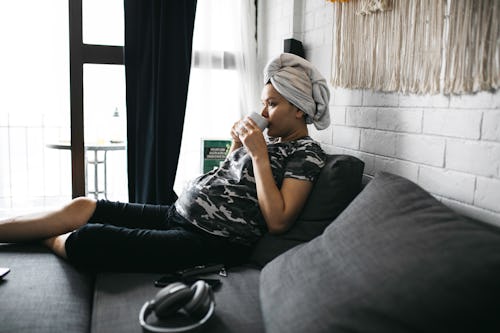
One of the most delicious parts of pregnancy is when you first feel those flutterings coming from your little fetus. Of course, as your pregnancy progresses, those wispy feelings turn into full-fledged kicks that can make you cross your eyes — and your legs. Even though you might be grateful for those times when Baby is snoozing and not turning your uterus into a dance floor, you might think that their siesta is taking a little too long. So if you’re wondering how to make your baby move or kick, here’s what you need to know.
How Often Should Your Baby Be Moving/Kicking?
Before you understand how to make your baby wiggle around in there, you need to know how often Baby should be moving in the first place. Pregnant women are often advised to use the “count to 10” method, according to a PubMedstudy, which means that they should feel 10 movements or more in a 2 to 3-hour period. If there are less than 10 movements, a woman should contact her healthcare provider to ensure baby’s well-being.
But Should You Make Your Baby Move/Kick?
If it’s been a while since baby has bounced around, you might start wondering about how to get your little one a nudge. But should you? “Yes, you should be able to feel your baby move or kick, but not necessarily make your baby move,” Dr. Vonne Jones, MD, a board-certified OB/GYN in Houston, TX, tells Romper. “Typically, when a fetus is less than 28 weeks, movement is spontaneous/intermittent, but after 28 weeks we do discuss kick counts.” Still, you shouldn’t make your baby move too much, Dr. Kim Langdon, MD, an OB/GYN tells Romper. “You can try to make your baby move if you want, but you shouldn’t do it too often as the baby sleeps a lot.”
Here’s How To Make Your Baby Move/Kick

Drink Something Cold To Get Your Baby To Move
If you’re looking to get your baby movin’ and groovin,’ there are a few ways to make it happen. The easiest one: get a big glass of water and start drinking. “Typically we recommend having a mom drink some cold water,” recommends Dr. Jones. “You can also drink something that has a little bit of sugar in it, since this can help us assess if Baby is appropriately moving.” It’s true: drinking a sweet, cold drink can stimulate your baby to move in the womb and is a method often used to trigger fetal movement, another study found.
Rub Your Belly To Make Baby Move
All those times that you touch your belly can be beneficial if you’re looking to count kicks. In fact, as your pregnancy progresses, rubbing your belly can elicit fetal activity, researchers found. Interestingly enough, moms-to-be who got a foot massage (as opposed to a hand massage) were more likely to get their babies moving. As it turns out, what feels good for momma also feels good to Baby, too.
Sing To Your Baby To Make Them Kick
If you thought those quick kicks to your ribcage were because you were singing off-key, think again. It’s actually quite the opposite: Baby loves listening to your voice, and in particular, when you’re belting out those big notes, according to Dr. Kecia Gaither, MD, MPH, FACOG, a double board-certified ob/gyn and Director of Perinatal Services at NYC Health + Hospitals/Lincoln. “Fetuses can hear by the late second trimester of pregnancy,” says Dr. Gaither. “So most moms can induce movement by singing or playing music.”
When you’re pregnant, you might obsess over every detail, including how often your baby moves. Although it’s important to count kicks to ensure Baby’s well-being, there are ways to get them to wake them up and get them moving. Think of it as payback for all those future sleepless nights your baby will put you through once they’re born.
Studies cited:
Koshida, S., Ono, T., Tsuji, S., Murakami, T., Arima, H., Takahashi, K. “Fetal movement frequency and the effect of associated perinatal factors: Multicenter study” 2018.
Bryant, J., Jamil, R. Thistle, J. “Fetal Movement” 2021.
Linde, A. Georgsson, S., Pettersson, K., Holmstrom, S., Norberg, E., Radestad, I. “Fetal movement in late pregnancy — a content analysis of women’s experiences of how their unborn baby moved less or differently” 2016.
Diego, M., Dieter, J., Field, T., Lecanuet, J., Hernandez-Reif, M., Beutler, J., Largie, S., Redzepi, M., Salman, F. “Fetal activity following stimulation of the mother’s abdomen, feet, and hands” 2002.
Experts:
Dr. Vonne Jones, MD, a board-certified OB/GYN in Houston, TX
Dr. Kim Langdon, MD, an OB/GYN
Dr. Kecia Gaither, MD, MPH, FACOG, a double board-certified OB/GYN and Director of Perinatal Services at NYC Health + Hospitals/Lincoln

0 comments:
Post a Comment